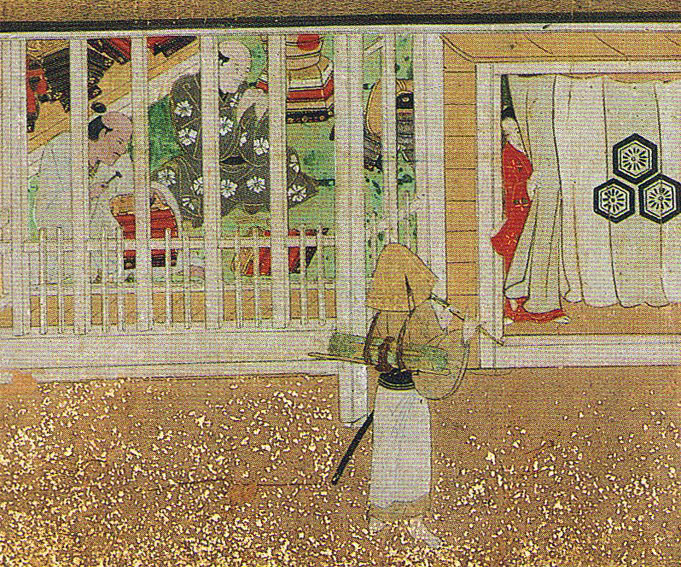|
1630 at the latest: Iwasa Matabei's Famous Painting of
Two 'Fuke-Komosō' With Swords & An Umbrella Maker
The basic information on this webpage was first published on the Internet, in an earlier version
of this website in early 2011; it was later expanded with significant new details',
some supplied in a new Youtube video by the Freer Gallery of Art | Smithsonian Institution, Washington DC, USA, on April 9, 2021.
Read more below.
INTRODUCTION
I discovered this really unique piece of early 17th Japanese art while Googling in the Japanese language already in January-February, 2011;
the search word back then was - among many others: 'Komusō', 虚無僧, of course.
The painting had been exhibited at The Nezu Museum in Tōkyō during the period
November 23, 2010, through December 23, 2010.
Dated by Japanese art specialists to have been created no later than 1630, that painting ranks among the absolutely most important and significant evidence-bearing illustrations in Japanese shakuhachi history!
Cheers ☺ Torsten O.

Painting of an Umbrella Maker & Two Fuke-Komosō
by Iwasa Matabei, 1578-1650
An "important work of art" dating from the early Edo Period,
17th century, before 1630.
Exhibited in late 2010 at the Nezu Museum, Tōkyō.
Official however highly questionable museological title of the work, back then:
傘張
り
•
虚無僧図
'Kasa-hari • komusō-zu'
"Picture of an Umbrella Maker & Komusō"
- exactly because those two flute players with their long swords
were in fact not 'Komusō', at all,
but 'Komosō', 薦僧!
According to recognized Japanese sources quoted on the internet,
this picture was originally 1 out of 8 illustrations on an exquisite folding screen
by Iwasa Matabei known as the 'Ikeda byōbu', among other names:
"The Ikeda Folding Screen",
池田屏風.
(Link to the web page in question: Cultural Heritage Online)
Japanese art specialists do date that folding screen
to the Kan'ei Period, 1624-1644 - but no later than 1630.
That means that the 'Fuke-Komosō'/Umbrella Maker picture is indeed very closely contemporary with the important Kaidō honsoku,
海道本則, document of 1628!
Read more about the Kaidō honsoku, the various versions, here:
1628: The Kaidō honsoku 'Fuke-Komosō' Credo
SIGNIFICANT UPDATE as of April 27, 2021
On April 9, 2021, this video, titled "Look & Listen: Nature in Japanese Art and Music" was published on YouTube by The National Museum of ASIAN ART/Smithsonian/Freer Gallery of Art/Arthur M. Sackler Gallery, on their "Smithsonian's National Museum of Asian Art" YouTube Channel:

"Look & Listen: Nature in Japanese Art and Music"
featuring Kurahashi Yōdō II, shakuhachi, and assistant curator of Japanese art at the Freer and Sackler, Frank Feltens.
Possibly, that unique painting by Iwasa Matabei may have been purchased by the Freer Gallery of Art at some time after late 2010?
Anyhow, the reproduction of Iwasa Matabei's painting here in the video, is indeed much more detailed than those previous ones presented online by the Nezu Museum around 2011, and before then:



PREVIOUSLY UPLOADED BACKGROUND INFORMATION between 2011 and 2020:
From November 23, 2010, through December 23, 2010, the Nezu Museum in Tōkyō exhibited a most extraordinary hanging scroll [kakejiku]
painted by the highly renowned early Edo Period painter Iwasa Matabei who lived from 1578 to 1650.
In the painting we see two figures wearing slightly pointed umbrella-shaped basket hats, both carrying rather long swords [Jap.: katana
刀] by their left sides.
Moreover, the two are seen to be playing some kind of (although more or less invisible) quite short and thin flute-like instrument:
Perhaps, a hitoyogiri? - or, maybe: a miyogiri!

Close view of two 'komosō' in "Picture of Parasol-maker & Komusō

Even closer view of two 'komosō' in Picture of Parasol-maker & Komusō"


'Kasa-hari • komusō-zu' on display (right) at Nezu Museum,
Tōkyō - November 23, 2010, through December 23, 2010
On this web page the picture can be studied in more detail - click underneath the illustration to enlarge:
Bunka Isan Online (Cultural Heritage Online)
Links to more information, online:
Nezu Museum exhibition highlights
Nezu Museum exhibition press material
www.wikipedia.org: Iwasa Matabei (in English)
www.wikipedia.org: Iwasa Matabei (in Japanese)
Kasa-hari • komusō-zu - online internet gallery with links (in Japanese)
Japanese web pages describing and discussing the Kasa-hari komusō-zu (in Japanese)
ANALYSIS
of the Kasa-hari • komusō-zu painting:
The painting appears to be quite contemporary with the documents Kaidō honsoku, 1628.
We know from the Keichō kenmonshū, 1614, that the Fuke monk/komosō being described there was indeed carrying a sword -
more specifically: a wakizashi 脇さし,
the shorter sword of the samurai.
In the Kaidō honsoku, the sword being carried by the komosō in 1628 is described as a katana
刀 - the long sword of the samurai.
After the middle years of the 17th century swords are no more to be seen in surviving pictorial representations of the "real-life" flute-playing mendicants -
with but one exception, the komusō picture in Kyotaku denki kokujikai, dated 1795.
In this context one specific, quite early komosō/komusō picture should be investigated:

Yet unidentified and undated early 17th century komosō picture
Posted on the internet by Mr. Dean Delbene, Chicago,
on September 6, 2009 (see link below)
Inquiring with Dean Delbene in January, 2011, I learned that we do - so far - know of no further, more specific documentation regarding this picture, its possible creator and approximate date of making.
In this picture we see a person who is apparently performing religious mendicancy in a street while wearing a rather large and deep,
softly pointed basket hat, a rolled up bed roll mat on the back, a long sword by the left side.
The instrument being played is a quite thin and significantly long vertical flute, compared with the shorter hitoyogiri and miyogiri vertical flutes, especially
- a dōshō
洞簫, perhaps?
Link to Dean Del Bene's Myōan Shakuhachi blogspot web page in question:
Myōan Shakuhachi c/o Dean Del Bene
|
|










